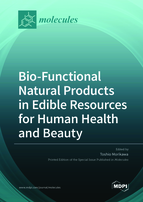Bio-Functional Natural Products in Edible Resources for Human Health and Beauty
A special issue of Molecules (ISSN 1420-3049). This special issue belongs to the section "Natural Products Chemistry".
Deadline for manuscript submissions: closed (31 January 2022) | Viewed by 38957
Special Issue Editor
Interests: isolation and structure determination of bioactive natural products; synthetic studies on bioactive natural products; structure-activity relationship studies on bioactive natural products; studies of bioactive natural products on the application to pharmaceuticals, nutraceuticals, dietary supplements, cosmetics, and food additives; mechanisms of action of bioactive natural products
Special Issues, Collections and Topics in MDPI journals
Special Issue Information
Dear Colleagues,
Natural products remain important repositories of promising therapeutic candidates due to their rich chemical and biological diversity. The Special Issue on "Biofunctional Natural Products in Edible Resources for Human Health and Beauty" is intended to offer biological active natural products from edible resources as candidates and/or leads for pharmaceuticals, dietary supplements, functional foods, cosmetics, food additives, etc. The research fields of this Special Issue include natural products chemistry, phytochemistry, pharmacognosy, food chemistry, bioorganic chemistry, chemical biology, molecular biology, molecular pharmacology, and other related research fields of bioactive natural products obtained from the edible resources. Here, we encourage investigators to consider submitting reviews, regular research papers, and short communications focusing on the different aspects. I look forward to receiving many submissions from outstanding experts in these research fields.
Prof. Dr. Toshio Morikawa
Guest Editor
Manuscript Submission Information
Manuscripts should be submitted online at www.mdpi.com by registering and logging in to this website. Once you are registered, click here to go to the submission form. Manuscripts can be submitted until the deadline. All submissions that pass pre-check are peer-reviewed. Accepted papers will be published continuously in the journal (as soon as accepted) and will be listed together on the special issue website. Research articles, review articles as well as short communications are invited. For planned papers, a title and short abstract (about 100 words) can be sent to the Editorial Office for announcement on this website.
Submitted manuscripts should not have been published previously, nor be under consideration for publication elsewhere (except conference proceedings papers). All manuscripts are thoroughly refereed through a single-blind peer-review process. A guide for authors and other relevant information for submission of manuscripts is available on the Instructions for Authors page. Molecules is an international peer-reviewed open access semimonthly journal published by MDPI.
Please visit the Instructions for Authors page before submitting a manuscript. The Article Processing Charge (APC) for publication in this open access journal is 2700 CHF (Swiss Francs). Submitted papers should be well formatted and use good English. Authors may use MDPI's English editing service prior to publication or during author revisions.
Keywords
- Natural product chemistry
- Phytochemistry
- Pharmacognosy
- Food chemistry
- Bioorganic chemistry
- Chemical biology
- Molecular biology
- Molecular pharmacology
- Isolation and structure determination
- Total synthesis
- Structure–activity relationship
- Mechanism of action







